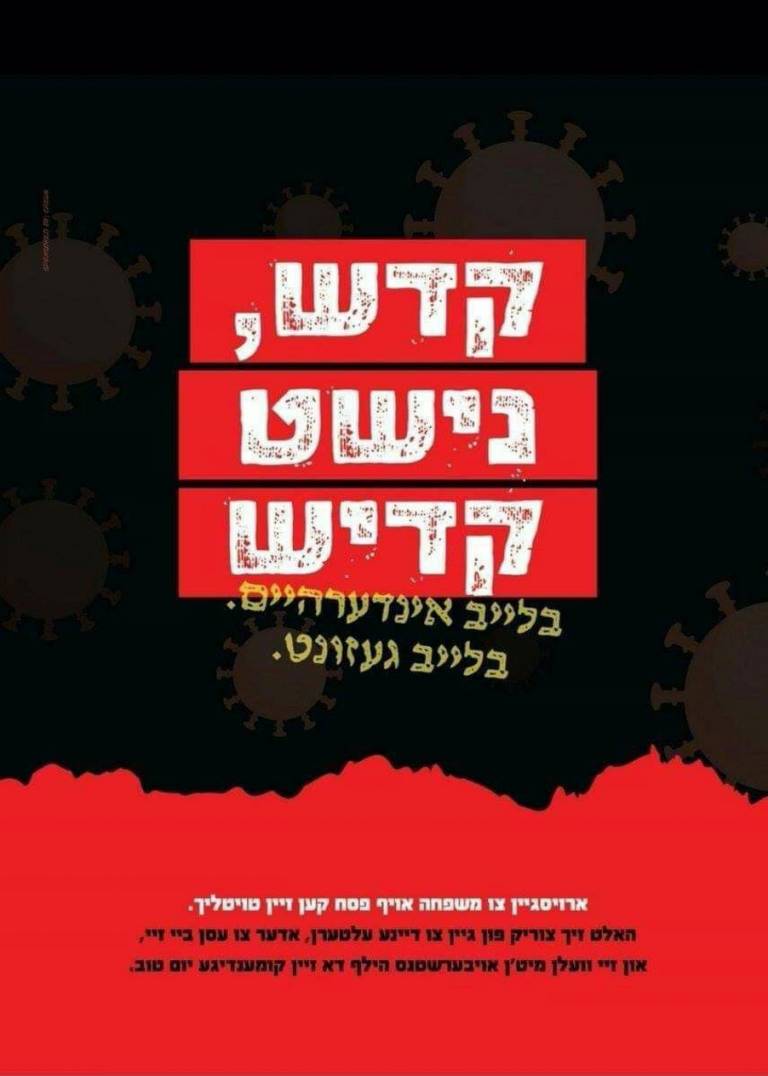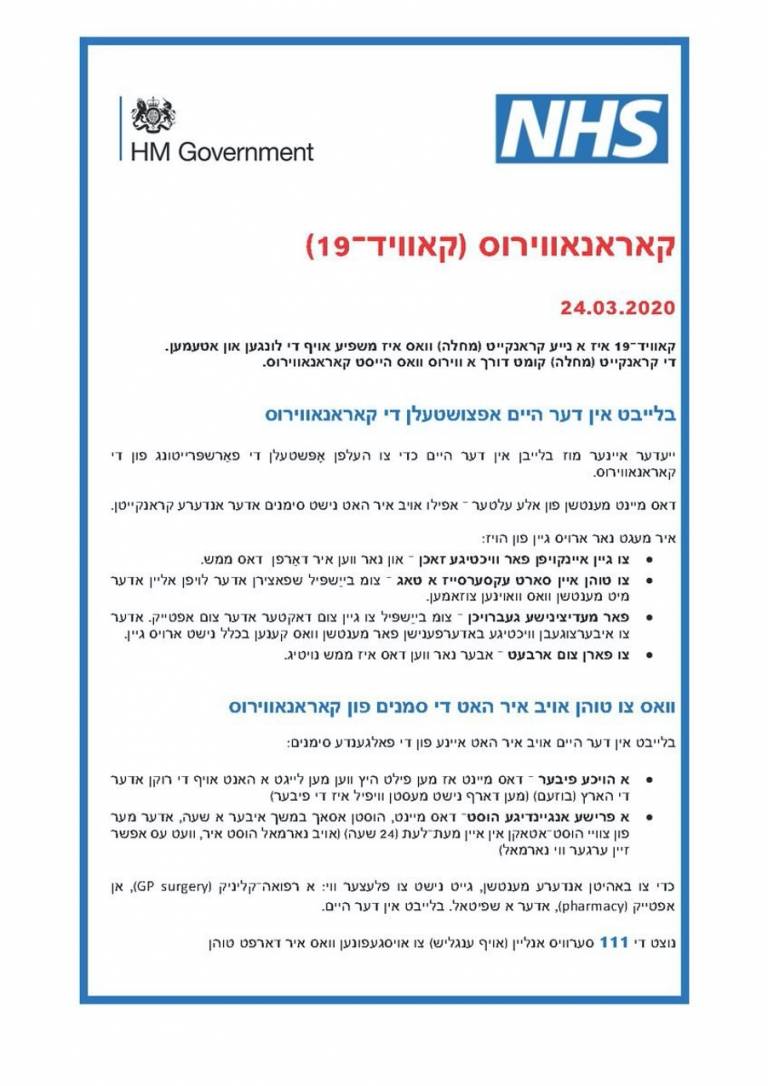Translating Covid-19 information into Hasidic Yiddish
6 May 2020
Members of the Contemporary Hasidic Yiddish research project on translating valuable information for a vulnerable community.

Above: Yiddish-language information poster produced for Hasidic communities before Passover, reading Kaddesh [an element of the Passover seder], not Kaddish [prayer for the dead]: Stay at home, stay healthy.
by Lily Kahn, Kriszta Eszter Szendrői, and Sonya Yampolskaya
For the past year we have been working on an AHRC-funded research project on contemporary Hasidic Yiddish based in UCL Linguistics and Hebrew & Jewish Studies. Yiddish, the traditional language of Eastern European Jews, had around 10-12 million speakers before World War II, but is today considered an endangered language. However, it remains the everyday language of up to 700,000 Hasidic Jews globally, with major centres in New York, London, Antwerp, Jerusalem, and Bnei Brak. Present-day Hasidic Yiddish exhibits striking linguistic differences from the traditional pre-war Eastern European dialects of the language as well as from its standardised variety. Nevertheless, despite the intriguing differences in its structure, and its central role in the contemporary Yiddish world, very few studies exist on Hasidic Yiddish grammar or language use. Our main aim is to change this situation by providing the first in-depth description of the grammatical and sociolinguistic features characteristic of the Yiddish used by Hasidic communities worldwide, and an analysis of their implications for linguistic theory. Our research team consists of four UCL-based linguists and three research assistants who are native speakers of Hasidic Yiddish from Stamford Hill and Israel.
Since the project began we have been focusing on collecting linguistic and sociolinguistic data from Yiddish speakers in the main Hasidic centres worldwide, with extended fieldwork conducted in London’s Stamford Hill, the New York area, and Israel. The Covid-19 pandemic put an abrupt stop to our work as we suddenly found ourselves unable to conduct interviews. We expected that we would spend the lockdown working on written materials and analysing data that we had already collected. However, like everything with this pandemic, things moved very quickly and we soon found ourselves with an unexpected role to play during the crisis.
All around the globe, Covid-19 has affected various groups of people unequally even within one country. Especially in the beginning, Hasidic communities appeared to be quite vulnerable to the pandemic in contrast with average numbers in the UK, USA, Israel, and Canada. The Hasidic community in London’s Stamford Hill comprises approximately 40,000 people, the majority of whom are Yiddish-speaking. The community is extremely tight-knit and members frequently avoid secular sources of information, especially online media. Moreover, many in the community are relatively unfamiliar with English. It is clear that a strong flow of information is a key means for all of us to shift our daily routine drastically to this new emergency mode of living, and the information flow to London’s Hasidic community was quite lacking. Given the fast-moving situation, health and police guidance started to appear in several waves on online forums which many in the Hasidic community do not have access to. In any community, it is natural that such inconvenient rules can be better adhered to if the authorities provide clear and transparent guidance as to why they have been put in place. We thus decided that we had a role to play in making such advice available in an accessible format, and immediately contacted the NHS, the Metropolitan Police and Hackney Council with an offer to provide them with a Yiddish translation of their Covid-19 guidance for the Stamford Hill Hasidic community. All three institutions were enthusiastically supportive of our endeavours. In addition, we also published information pages in a local magazine in Stamford Hill which reaches over 5,000 households.
We decided to translate the official guidance into colloquial Hasidic Yiddish, a generally spoken variant of the language employing vocabulary, grammar, and expressions that are perhaps surprising to the eyes of a trained Yiddishist, who is accustomed to the literary version of the written language. Our translation process was a team effort, with one native speaker of Israeli Hasidic Yiddish and one linguist producing the first draft, which was then checked with the other members of the team. Two of these are native speakers of Stamford Hill Hasidic Yiddish, who scrutinised the text to make sure that it reflected vocabulary and usage characteristic of the community rather than that of Israel.
Although there is a high degree of linguistic similarity between the various Hasidic Yiddish-speaking communities around the world, there are also a number of noteworthy differences. Some of these raised interesting questions during the translation process. For example, our Israeli team member sometimes employed Hebrew-derived vocabulary, while our Stamford Hill team members were often unfamiliar with these and would instead use a Germanic equivalent, or in certain cases an English loanword.
Hasidic Yiddish is also used differently by men and women in certain respects, and some of these gender differences played a role in the translation. For example, we had a discussion about the best way to translate the word ‘essential’, which lacks a straightforward equivalent in Hasidic Yiddish. One option, הכרח hekhrekh, a Hebrew-derived term suggested by our male researchers, was rejected by the female members of the team, who pointed out that women would be unlikely to understand it. This is because the term is typically used in legal contexts and would be familiar to men from their studies in yeshivah (Talmudic academy), which women do not attend.
As well as these regional and gender-based challenges, there were also interesting challenges relating to the formulation of understandable Yiddish versions of certain key terms. For example, the phrase ‘social distancing’ has only recently come on the radar of English speakers, and lacks a recognised Yiddish counterpart. In this case, the team used the Yiddish phrase מענטשלעכע דערווייטקייט mentshlekhe dervaytkayt ‘personal distancing’, which conveys the sense of the original and has a relatively transparent meaning. One particularly memorable discussion involved arguably the most important word of the entire translation, ‘cough’. There are two variants of this verb in Yiddish, הוסטן hustn and היסן hisn, both of which are in use in the Hasidic world. Different members of the research team, as well as other Hasidic Yiddish speakers with whom we consulted, had particularly strong opinions about which was the correct one to use, and it was important to come to a satisfactory solution for such a crucial word in the context of the information we were trying to convey!
In addition to the linguistic issues concerning the translation, there were also cultural factors to be taken into account. The NHS and police information did not contain any mention of specifically Jewish issues, such as prohibitions on going to the mikveh, forming minyanim, attending synagogue services, etc. We felt that it was vital to include details of these culturally salient topics so that the translated notices would be as helpful and comprehensive as possible for Hasidic Yiddish-speaking readers. We were pleased that the NHS and police allowed us to make these additions so that the final products were not only in Yiddish, but also culturally relevant for the intended readership.
It has been a very moving experience producing these translations, and even more so to hear reports of them being disseminated in North London. We were particularly touched to receive a positive message from a friend of a friend living in Stamford Hill who had seen the Yiddish information on display in the community. It is our sincerest hope that these translations will go some way towards helping to support London’s Yiddish-speaking residents in these grim times.

 Close
Close

